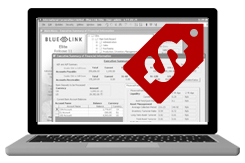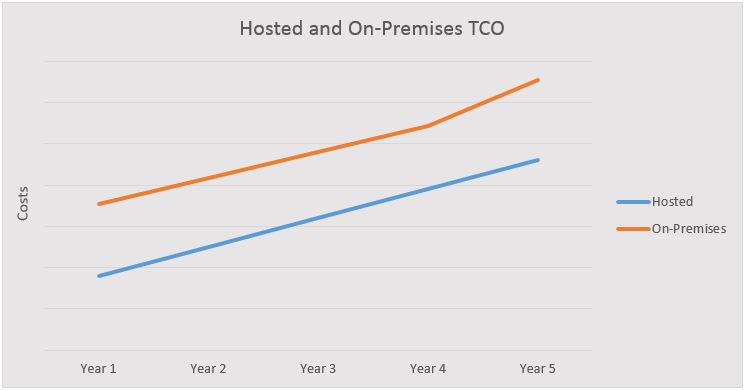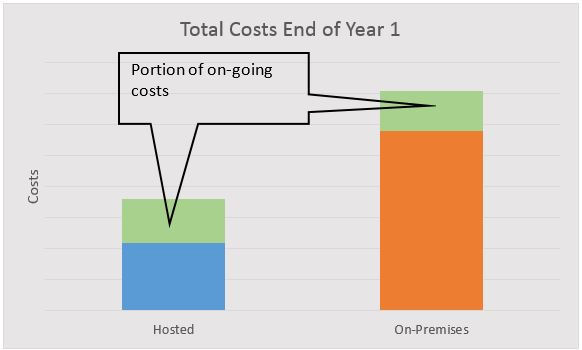When your business decides to purchase inventory and accounting ERP software, the great debate remains: should you implement a hosted solution or on-premises? For smaller organizations, the answer is obvious – when you compare the total cost of ownership per year, hosted software will almost always end up being the most economical choice (as shown in Graph #1). Some software vendors do not even give you the option, but instead only offer hosted/cloud-based solutions. However, there are some instances where a cloud-based solution is just not feasible – for example, businesses in rural locations without a reliable internet connection, and for larger organizations, on-premises solutions can be the better option. Either way, it is important to fully understand both options and the implications they will have for your business. Hesitation regarding hosted software frequently stems from a lack of understanding and concerns regarding data security issues. However, even though data security will vary by the software vendor, the security and provisions put in place by vendors in general will be more than what you can provide in an on-premises environment.
Although “small business” is a relative term, it is often used to describe companies with a small number of employees, limited resources, low order volume and moderate revenues. For these types of businesses, a simple comparison of costs will almost always show cloud-based solutions as the more economical choice, but let’s break down exactly why that is.
When you compare hosted and on-premises solutions, it is important to include all costs associated with maintaining the system year-over-year, and it is best to track the total cost of ownership over a 5 year period. Evaluating the costs after year one is not a good assessment of which is more economical as it does not take into consideration all the costs associated with maintaining the system in the long run. Given that software is designed to be a long-term investment, it is important that the costs are evaluated as such.
Hosted Costs
For hosted software, year 1 costs will typically include initial implementation and set-up, monthly license fees and support. On-going costs are then made up of licenses fees and support, as maintenance fees for warranty issues and access to regular upgrades are built into the monthly fees. Under this model, IT maintenance and data backups become the responsibility of the software provider and powerful server hardware is not required. A subscription-based cost structure is beneficial for small businesses as it allows it to gain control over its software expenditure. Instead of a large initial investment, the costs of the system are broken down into a one-time implementation and set up fee and then on-going monthly fees. This allows businesses to plan and implement a predictable schedule of monthly payments.
On-Premises Costs
With on-premises software, year 1 costs will typically include initial implementation and set-up, license fees, support, and hardware and equipment purchases and management. On-going costs are then made up of managing the system infrastructure, support, and maintenance. It is frequently these on-going costs that are not accounted for properly in the long run, but they have a huge impact on total cost of ownership. One of the more costly aspects of on-premises implementations is server and equipment purchases and maintenance, especially for small businesses. Even if you don’t originally need to update your servers when you purchase new software, this equipment will need to be replaced give or take every 5 years and doing so can be very expensive. There are also costs associated with managing these servers, such as data backups, performance monitoring, patch installation and other software license purchases. Software maintenance is another on-going cost associated with on-premises solutions. Implementing the right software system is a long term investment and maintaining an active warranty with regular access to upgrades will help to ensure that it is.
For those smaller organizations that choose to implement on-premises based software, the management of servers is frequently outsourced to a 3rd party IT company or someone is hired for the role. This adds extra costs to an already expensive project and takes resources away from growing the business and managing existing customers, to managing IT. For larger organizations, there is frequently already a team of in-house IT personnel who are able to dedicate their time to server and equipment management.
Technology and the business environment are two of the fastest changing aspects of our world and so it is increasingly important to make sure that your business is always taking advantage of the best that your software has to offer and that your software matches the business requirements of the time. Trying to save money by not upgrading your hardware or system on a regular basis can affect company performance and your bottom line. When used and maintained properly, software becomes a strategic investment to help run and grow your business. As a small business it is especially important to invest in a system and software vendor that can become a trusted business partner, offering expert advice to help your business save costs, increase efficiency and take advantage of new opportunities.












